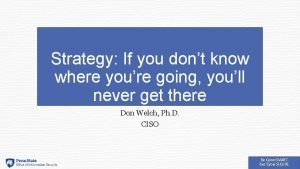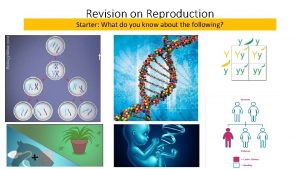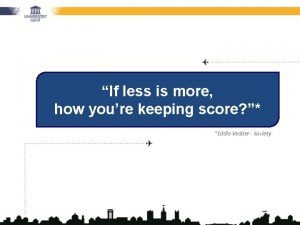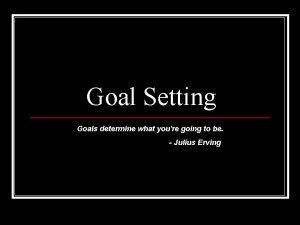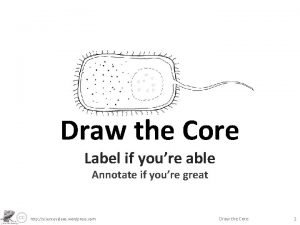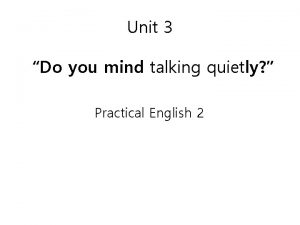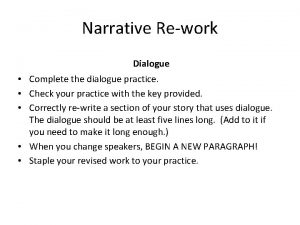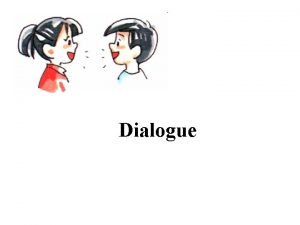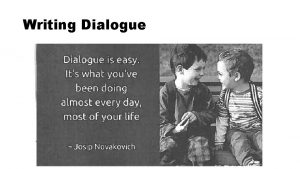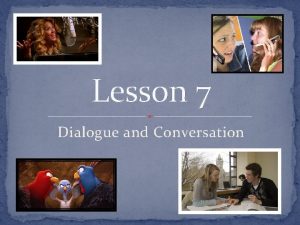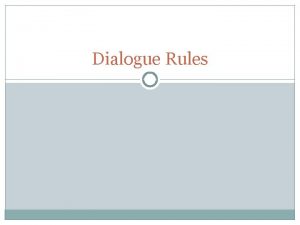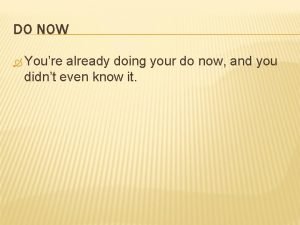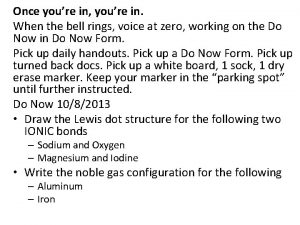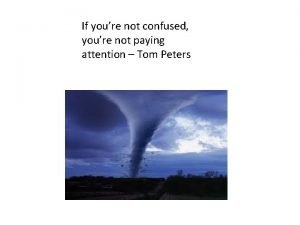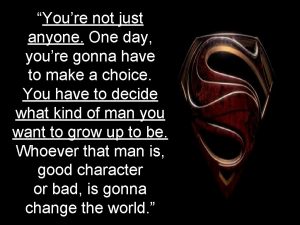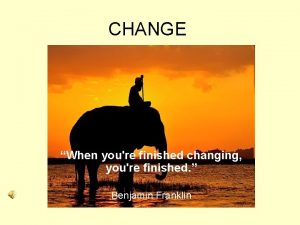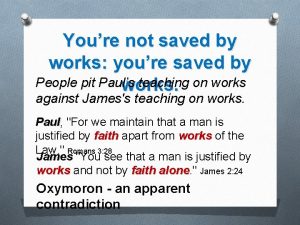Dialogue Now Youre Talking Dialogue is how you


























- Slides: 26

Dialogue Now You’re Talking! Dialogue is how you communicate when you’re having trouble communicating. Dialogue Now You’re Talking! © Quality Media Resources, Inc.

Group Exercise I: Overcoming Obstacles to Dialogue n n Dialogue Now You’re Talking! Identify the one Rule of Dialogue that seems most difficult to attain in your work group or community. For example, it may be suspending status, or deferring decisionmaking. Spend five to ten minutes discussing how you and your associates might overcome this problem. Your team should be prepared to report back to the group on which Rule of Dialogue you selected and what strategies you discussed for better implementing that rule when having a dialogue in your organization. © Quality Media Resources, Inc.

Group Exercise II: Listening with Empathy and Asking Clarifying Questions n n n Dialogue Now You’re Talking! Part I Describe to your partner an important event or decision you feel strongly about. Your partner should then rephrase the story, describing both the story and how you felt about it. Let your partner repeat and revise his/her account until you accept it as accurate. After each revision, your partner is permitted to ask clarifying questions to which you should respond as non-defensively as possible. © Quality Media Resources, Inc.

Group Exercise II: Listening with Empathy and Asking Clarifying Questions n n Switch roles with your partner and repeat the exercise, using an experience that is meaningful to the other person. You should be prepared to report back to the workshop on what happened, for example: l l Dialogue Now You’re Talking! Part 2 l l How many repetitions did it take in each case? What clarifying questions were most helpful in developing an understanding? What barriers were there to developing that understanding? Did you feel your partner heard and understood your story? What gave you that feeling? © Quality Media Resources, Inc.

Group Exercise III: Suspending Decision Making n n Dialogue Now You’re Talking! Identify what was done in the Dialogue – Now You’re Talking! video you’ve just seen to separate dialogue and decision-making and discuss whether that approach might work in your organization. Identify one or two practical steps that could be taken to separate dialogue from decision-making in your organization. © Quality Media Resources, Inc.

Part I Group Discussion Questions Communicating in a Diverse World 1. What kinds of people do you find it most difficult to communicate with? What do you suppose are the barriers to effective communication with these people? 2. What would the benefits of Dialogue be to your organization? To the individuals in your group? 3. Why is it important to suspend status in a Dialogue? Dialogue Now You’re Talking! 4. What are some situations or circumstances that would be better suited to negotiation, debate or presentation? How would those discussions differ from a Dialogue?

Part 2 Group Discussion Questions Communicating in a Diverse World 5. When Daniel says to Rebecca “Let me try it for you a bit slower, Rebecca, Faster, Better, Cheaper…” what is the likelihood that she will begin to understand or agree with the real issues concerning Daniel? When Rebecca responds that “you people just need to do your job properly, ” is she understanding Daniel’s work process? 6. What is Daniel’s key “hidden assumption”? 7. What is Rebecca’s key “hidden assumption? ” Dialogue Now You’re Talking! 8. How does revealing these assumptions help both Daniel and Rebecca? © Quality Media Resources, Inc.

Part 1 Group Discussion Questions Dialogue for Cultural Understanding 1. When Cleo says that she doesn’t want to discuss the issues and would rather “save it for later, ” what messages is she sending her co-workers? 2. When David challenges Beroz, asking how this dialogue will impact the team’s ability to serve customers, and not just Beroz’s feelings about the team, which rules of Dialogue is David violating? Dialogue Now You’re Talking! 3. When David asks Lonnie how long he plans to “sit in that chair answering to someone else, ” and asks Beroz if the team members “should run to her each time there’s a problem, ” you could say that he is asking clarifying questions. Is he?

Part 2 Group Discussion Questions Dialogue for Cultural Understanding 4. How might David have asked Beroz to clarify how team members should handle difficult problems if he was listening with empathy? 5. Do you think Beroz’s ethnic background is central to David and Cleo’s concerns? 6. Do you think the team would have had a problem with Beroz as an Indian woman joining them in a non-supervisory role? Dialogue Now You’re Talking! 7. Can you think of a situation in your own work experience where what appeared to be a case of ethnic or racial discrimination was actually about something else? How was the real cause uncovered in that situation?

Part 3 Group Discussion Questions Dialogue for Cultural Understanding 8. How did Beroz get David and Cleo to move away from defensive, debating positions and toward revealing their true hidden assumptions and, ultimately, finding common ground for later discussions? 9. What added lessons could Beroz (and Rohit) take from the Dialogue with the team members, to minimize the chances for similar tensions in the future? Dialogue Now You’re Talking! 10. What was the benefit of “suspending status” to this dialogue between Beroz and her team? © Quality Media Resources, Inc.

Part 1 Group Discussion Questions Dialogue between Genders 1. What was gained by having Meg and Jim work out their conflict through a group dialogue, rather than one-on-one? What did the other team members contribute to the dialogue? 2. Who in the group asks the most clarifying questions? Apart from eliciting further information from Meg, how do these questions contribute to the dialogue’s atmosphere? Dialogue Now You’re Talking! 3. Cite some examples of someone in this dialogue trying to “speak for others. ”

Part 2 Group Discussion Questions Dialogue between Genders 4. How might Jim have rephrased some of his perceptions about where Meg was coming from to make it less likely that Meg would feel defensive? 5. What are some examples of “common ground” that are emerging from this dialogue? 6. What are some of Jim’s hidden assumptions that emerge in the program? Dialogue Now You’re Talking! 7. What follow-up would you recommend that Bob, the team’s leader, should do to ensure that the benefits of this dialogue aren’t lost? © Quality Media Resources, Inc.

Part 1 Group Discussion Questions Dialogue among Generations 1. When the dialogue began, why was it important that Kelly asked Donna not to serve as the facilitator for the process? 2. What are the hidden assumptions and feelings that Janet is reluctant to reveal? Dialogue Now You’re Talking! 3. When Janet says things like “you remind me of my daughter, ” or “I understand where you’re coming from, because 15 years ago I was in the same place, ” why does this not come across as empathy, as trying to find common ground?

Part 2 Group Discussion Questions Dialogue among Generations 4. Andy explains his position that face-to-face interaction is best for productivity and teamwork. Angie feels that she does her best work without the distractions of the office setting. Do these two find any common ground through the dialogue? 5. Do you think that this dialogue could have taken place without the face-to-face interaction that Andy prefers? Dialogue Now You’re Talking! 6. If there had been a push for a decision at this meeting, how might that have influenced the dialogue?

Part 3 Group Discussion Questions Dialogue among Generations 7. Who do you think modified their initial position the most? Why? 8. What did Janet learn through the Dialogue that she did not appreciate before? Dialogue Now You’re Talking! 9. How might dialogue help this group learn about changes in the past 15 years that make Angie’s interest in working at home, or Kelly’s interest in flex time, more reasonable for the organization now than they were when Janet first joined? © Quality Media Resources, Inc.

The Six Basic Rules of Dialogue 1. 2. 3. 4. 5. Dialogue Now You’re Talking! 6. Be open and suspend judgment – don’t disparage other points of view. Keep dialogue and decision-making separate - dialogue precedes decisionmaking, negotiation or action. Speak for yourself, not as a representative, and treat all participants as peers. Listen with empathy - acknowledging you have heard others and that you care. Look for common ground – identifying areas where you agree. Search for and disclose hidden assumptions - especially in yourself. © Viewpoint Learning, Inc.

Advocacy / Debate versus Dialogue Advocacy/Debate Part 1 n n n n n Dialogue Now You’re Talking! Assuming that there is one right answer (and you have it) Combative: attempting to prove the other side wrong About winning Listening to find flaws and make counterarguments Defending your assumptions Criticizing the other side’s point of view Defending one’s views against others Searching for weaknesses and flaws in the other position Seeking an outcome that agrees with your position © Viewpoint Learning, Inc

Advocacy / Debate versus Dialogue Part 2 n n n n Dialogue Now You’re Talking! n Assuming that others have pieces of the answer. Collaborative: attempting to find common understanding About finding common ground Listening to understand find a basis for agreement Bringing up your assumptions for inspection and discussion Re-examining all points of view Admitting that others’ thinking can improve one’s own Searching for strengths and value in the other position Discovering new possibilities and opportunities © Viewpoint Learning, Inc

Listening with Empathy 1. 2. 3. 4. 5. Dialogue Now You’re Talking! Try to see things from the others’ perspective. Reflect back what others have told you, showing that you are listening and that you care about their concerns. Ask clarifying questions to further your own understanding and to help others articulate their thoughts. Search for areas of common ground and identify where you find merit in their positions. When persuaded to modify your own positions, acknowledge the changes graciously and responsibly. © Viewpoint Learning, Inc

Some benefits of Dialogue n n n n Dialogue n n Now You’re Talking! Dispels mistrust. Breaks through negative stereotypes, revealing the common humanity of participants. Shifts from impersonal transactions to relationships, creating community. Makes participants more sympathetic to one another, even when they disagree. Prepares the ground for decision-making on emotion-laden issues. Helps to bridge subcultures and to clarify value conflicts. Expands the number of people committed to the process. Brings out the best in people. Creates a climate of good faith. © Viewpoint Learning, Inc

Leave Status and Decision-making at the Door n n n Dialogue Now You’re Talking! Part 1 Dialogue requires suspending status and treating all participants as equals Decision-making requires reintroducing status so those in authority can act For Dialogue to work, status distinctions must be suspended For decision-making to work, status distinctions must be respected Make the transition from dialogue to decision making explicit. Dialogue precedes decision making © Viewpoint Learning, Inc

Leave Status and Decision-making at the Door n n Dialogue Now You’re Talking! Part 2 Be clear that status distinctions and the usual decision-making hierarchy are suspended during the dialogue. Conduct the dialogue in a setting that is different from the settings used for decision-making. Use a facilitator rather than having one of the higher status individuals “chair” the session. Undertake role-playing and teambuilding exercises. Higher status individuals should participate alongside all others. © Viewpoint Learning, Inc

Part 1 THE ICEBERG Above the Surface Below the Surface Dialogue Now You’re Talking! Underlying Frameworks © Viewpoint Learning, Inc

Part 2 Uncovering Hidden Assumptions n Dialogue Now You’re Talking! ABOVE THE SURFACE Speech and visible action… … but the same statements and actions can be interpreted in many different ways — so there’s plenty of opportunity for misinterpretation or misunderstanding. © Viewpoint Learning, Inc

Part 3 Uncovering Hidden Assumptions n Dialogue Now You’re Talking! BELOW THE SURFACE Assumptions (often unconscious) shape how we interpret what we see and hear. l silent thoughts - we have discussions with ourselves about what we are experiencing and why it’s happening l we make calculations about the motivation behind the words and actions of others, we defend ourselves from real or imagined attacks l valid information is difficult to get, so we rely on (often hidden) assumptions to make sense of what we are seeing and to draw conclusions © Viewpoint Learning, Inc

Part 4 Uncovering Hidden Assumptions n UNDERLYING FRAMEWORKS Assumptions, in turn, grow out of underlying belief systems, culture and worldview that are seldom examined or challenged by those who hold them. Dialogue Now You’re Talking! © Viewpoint Learning, Inc
 Now i see it now you don't
Now i see it now you don't Professional letters
Professional letters How to act angry
How to act angry Hope youre doing well
Hope youre doing well Jesus you're my firm foundation
Jesus you're my firm foundation Random compliment generator
Random compliment generator Your grace, my master
Your grace, my master Cybersmart definition
Cybersmart definition Being asexual
Being asexual Diamante poem about love
Diamante poem about love How youre
How youre Review and revise your tentative goal statement
Review and revise your tentative goal statement Youre able
Youre able And the tree was happy but not really
And the tree was happy but not really Hi hi how are you doing
Hi hi how are you doing Now act out the following dialogue
Now act out the following dialogue Would you mind not talking during the lesson
Would you mind not talking during the lesson If a fly collides with the windshield of a fast-moving bus
If a fly collides with the windshield of a fast-moving bus Do you mind clean
Do you mind clean Would you mind talking to me
Would you mind talking to me Dialog expression of congratulation
Dialog expression of congratulation Guttering definition ww1
Guttering definition ww1 The god of peace himself
The god of peace himself I beseech you therefore brethren by the mercies of god
I beseech you therefore brethren by the mercies of god He probably loves (you) now
He probably loves (you) now Hooray cheered gilda. does that mean we can stay
Hooray cheered gilda. does that mean we can stay Shakespeare sonnet structure
Shakespeare sonnet structure







